arts organizations
Archived Posts from this Category
Archived Posts from this Category
Posted by ben on 14 Jul 2008 | Tagged as: arts organizations, books, essays
According to the Grande Encyclopédie, the first museum in the modern sense of the word (that is to say the first public collection) would seem to have been founded on 27 July 1793, in France, by the Convention. The origin of the modern museum would thus be linked to the development of the guillotine. However, the Ashmolean Museum in Oxford, founded at the end of the 17th century, was already a public collection belonging to the University.
The development of museums has plainly surpassed even the most optimistic hopes of the founders. Not only does the totality of the world’s museums today represent a colossal accumulation of riches but, above all, the totality of visitors without any doubt represents the most grandiose spectacle of a humanity freed from material cares and dedicated to contemplation.
We must take into account the fact that the galleries and the objects of art are no more than a container, the contents of which is formed by the visitors: it is the contents which distinguish a museum from a private collection. A museum is comparable to the lung of a great city: every Sunday the throng flows into the museum, like blood, and leaves it fresh and purified. The pictures are only dead surfaces and it is within the crowd that the play, the flashes, the shimmerings of light technically described by the authorised critics takes place. On Sundays, at five o’clock, at the exit door of the Louvre, it is interesting to admire the torrent of visitors, visibly animated with a desire to be in all things at one with the celestial apparitions with which their eyes are still ravished.
Grandville has schematised the relations between the container and the contained in museums by exaggerating (at the very least, on the face of it) the bonds that are temporarily established between the visited and the visitors. In the same way, when a native of the Ivory Coast places polished stone axes of the Neolithic period in a container filled with water, bathes in the container, and sacrifices chickens to what he believes to be thunder stones (fallen from heaven in a thunderclap), he is doing no more than prefiguring the attitude of enthusiasm and profound communion with objects which characterises the visitor to a modern museum.
The museum is a colossal mirror in which man contemplates himself, in short, in all his aspects, finds himself literally admirable and abandons himself to the ecstasy expressed in all the art journals.
— Georges Bataille, Encyclopaedia Acephalica
Posted by ben on 01 Jul 2008 | Tagged as: acquisitions, adventure day, arts organizations, design, photography, politics, public art
It was closing time at my neighborhood bar, the three of us leaning on a concrete table surrounded by cactus, when I heard about the dumpster full of art. A large scale public mural by Anton Vidokle was in the process of being removed by a company which had bought the building. The mural, an application of 100 vinyl decals on metal panels, depicted simplified versions of logos from bankrupt companies. Now the panels were being removed and thrown in a dumpster in the parking lot next to the building.
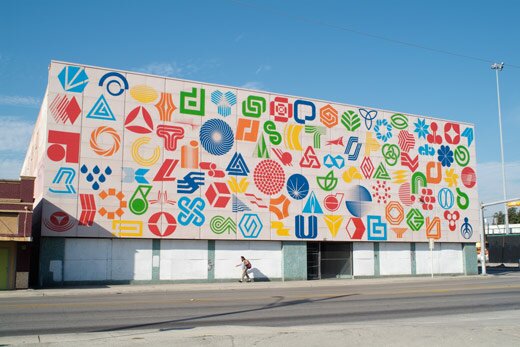
Installation shot of 100 Bankrupt Corporations (public geometry) by Anton Vidokle (courtesy Artpace)
We finished our beers, jumped in the car, and headed downtown. When we found the dumpster at around one in the morning, we realized immediately that we weren’t the first San Antonio art scenesters to have this idea. While almost all of the panels had been removed from the building, only a dozen or so were left in the dumpster. We jumped in and started throwing our favorites out into the parking lot. After cramming as many as we could into the trunk of the car, we took off, leaving a few for any other art scavengers who might not look down their noses on dumpster diving. After installing a panel with red semi-circular fragments of anonymous logos in my living room, I started noticing the other pieces around San Antonio. Stacked up near studios, hanging on workshop walls, leaning up against houses, they spoke of something just out of reach. Over the course of their lives, from symbols of production and commerce which drowned in a sea of such symbols, to their resurrection as material for an intricate yet minimal public mural, and finally to their cold, arbitrary fragmentation along the lines of a surface grid, they moved from abstraction to abstraction, carrying bits of identity from place to place.


Photos of Vidokle panels in the wild by Justin Parr
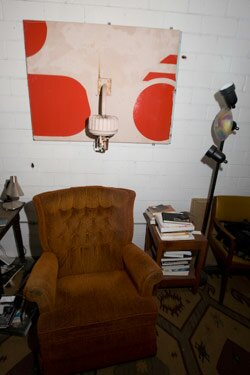 For a long time I waited for the few remaining panels along the top and down one side of the building to be removed. Every time I drove down San Pedro I looked to see if a few more of these public geometries had been taken from the face of the building, if perhaps the dumpster might have a few more treasures in it. And for a long time nothing happened. The building remained unchanged. After some months I forgot about the few logos that remained in their public home, and the mostly-deconstructed facade slowly slipped into the background of my focus.
For a long time I waited for the few remaining panels along the top and down one side of the building to be removed. Every time I drove down San Pedro I looked to see if a few more of these public geometries had been taken from the face of the building, if perhaps the dumpster might have a few more treasures in it. And for a long time nothing happened. The building remained unchanged. After some months I forgot about the few logos that remained in their public home, and the mostly-deconstructed facade slowly slipped into the background of my focus.
Then one day it was gone. Not the facade, the panels that were always too exentric to remain for long, but the building itself, which had been reduced to a heap of rubble. A slight controversey ensued, but that too will slip from the front of our minds before long. Still, these little pieces of the mural endure, reminders of the simplified, fragmented memories we collect from our meanderings through the city; reminders of the sometimes crude identities we carry with us, and the ways they can be resurrected, transformed, annihilated.
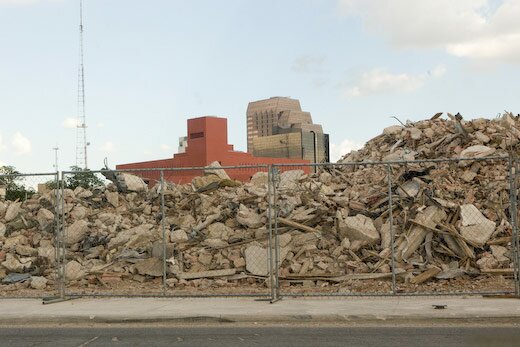
Photo of Jorrie Furniture Building rubble by Justin Parr
Posted by ben on 25 Jun 2008 | Tagged as: arts organizations, opportunities
Just a reminder for those of you planning on entering the Texas Biennial Group Show: the call for entries deadline has been extended until June 30. More information here.
Posted by ben on 24 Jun 2008 | Tagged as: acquisitions, arts organizations, responses/reviews
 The McNay holds a special place in many of our hearts. I’m not alone in having visited the museum over the years, finding my relationship with certain works growing stronger each time I returned. The lovely dreamlike Redon, the Waterlilies, a little Matisse sculpture — all carefully presented in this old Spanish colonial mansion. Sometimes a piece might pop up that I’d seen a hundred times but never really looked at. So it goes. Almost everyone, in every city, has their little aesthetic oasis. And that little oasis will inevitably change, growing or withering depending on the whims of fate. Now the McNay has a new $50 million wing.
The McNay holds a special place in many of our hearts. I’m not alone in having visited the museum over the years, finding my relationship with certain works growing stronger each time I returned. The lovely dreamlike Redon, the Waterlilies, a little Matisse sculpture — all carefully presented in this old Spanish colonial mansion. Sometimes a piece might pop up that I’d seen a hundred times but never really looked at. So it goes. Almost everyone, in every city, has their little aesthetic oasis. And that little oasis will inevitably change, growing or withering depending on the whims of fate. Now the McNay has a new $50 million wing.
As I thought about the McNay’s new Stieren Center, and what to say about it, I came across Jed Perl’s rumination on museums in the last issue of the New Republic. A lot of it is standard Jed Perl: bitching about the art market, trashing Koons and Hirst and Eliasson, along with some of America’s biggest art institutions. Fair enough — he makes plenty of good points, even if his tirades are a bit predictable at this point. But Perl also develops the notion that the museum ought provide a stable sense of place. And that art itself ought to offer a world to enter into — not just a wry joke or another brand name to buy into.
Perl talks about the reluctance of the New Museum and the Broad Contemporary Art Museum to offer the visitor a sense of ground, of rootedness. For those of us who have lived in San Antonio for a while, or who grew up here, the McNay has always had that sense of place. It is intimate and stable — you can form a relationship with it that endures and grows. So how does the new Stieren Center fit into this concept of the museum as a grounding, intimate public space?
The building itself is nice. It’s nice to have a space at the McNay that was made for looking at art. There’s the high-tech glass ceiling that adjusts to the natural light, and indoor lights set to automatically supplement the sun when necessary. The flow of the galleries works pretty well, and there’s a sense of elegance to the space. Some of my architect friends complain that it’s a Renzo Piano rip-off, and considering how close we are to the Menil, it’s a bit disappointing to have that shadow cast over the space from the very beginning.
But then you see the art. The innaugural exhibit brings out the big guns that have for some reason been collecting dust in the McNay’s attic. Beautiful works by Joseph Cornell, Jean Arp, John Chamberlain, Paul Feeley, John McLaughlin and on and on fill the space (and more contemporary names too — Kiki Smith, Sandy Skogland, Ernesto Pujol). The show’s not so cohesive — the visitor has to move quickly from Op Art to Minimalism to Abstract Expressionism to Conceptualism — but the groupings generally work, and as a collection of modern and contemporary art, I think it’s stronger than the offerings at SAMA or the Blanton in Austin; definitely a major contribution to our city’s culture.
Then it dawns on me: there’s another show coming up in August? Where is all this work going? Back in the attic? And this is where we start to get back into groundedness. In a New Light is honestly a show I could visit many times over, and knowing that it will come down to make way for touring exhibits in a month or two is painful to consider. I take heart in the fact that René Barilleaux has organized some wonderful contemporary shows over the years, and will be able to do so much more with this new space. But at the same time I lament that this part of the collection is not one that I will grow to know as I have the more traditional work in the museum’s collection.
Posted by ben on 19 Jun 2008 | Tagged as: arts organizations, upcoming events

For those of you in San Antonio with a little time and cash on your hands tonight, head on over to Blue Star for their annual Red Dot event — a wide range of artists will have work for sale. I believe tickets are $75 (can’t find the info on Blue Star’s site).
Posted by ben on 16 Jun 2008 | Tagged as: arts organizations, photography, responses/reviews
Tyler Green points to posts by Daniel Drezner and Barry Gewen regarding the fate of the public intellectual in recent years. Drezner argues that, partly thanks to the blogosphere, the pool of public intellectuals is as strong as ever. Gewen thinks Drezner’s playing fast and loose with the term “public intellectual” — and in some cases I’m inclined to agree. I would consider Joshua Micah Marshall and several others on the list to be dedicated political analysts, although I think other names on Drezner’s list do make the cut (Christopher Hitchens and Andrew Sullivan, for instance).
At any rate, Green brings up the question of how many public intellectuals spend much time talking about visual art these days, and I think he’s right that the answer would be “not very many” (although I see no reason Dave Hickey couldn’t slip into Drezner’s list). But his explanation for this fact — that art critics “tend to burrow and bunker into the safe little cocoon of the art world, rarely engaging issues, ideas outside the ghetto” — needs some unpacking. It’s true that the visual art world can be insular in a lot of ways. I think part of the reason for this is that it is one of the few creative communities that has not embraced mass production in a comprehensive way. A work of visual art, unlike a typical book, album, or film is almost always limited in quantity. When it’s not (see Felix Gonalez Torres), it’s usually to make an abstract point about materiality or something. Even artists who use inherently reproducible media (e.g. photography) artificially limit their works to editions, apparently in order to remain within the prescribed economic structure of the art world. This makes the underlying structure of the art world inherently elitist.
But I think there’s another, perhaps more meaningful reason that the visual arts are rarely part of a broader public discourse (after all, every form of intellectualism tends toward elitism). While Green says that visual art “rarely engag[es] issues, ideas outside the ghetto,” visual artists work hard to embrace other disciplines and incorporate them into their toolbox. There has been a steady trend of breaking down these barriers between art forms at least since Duchamp. But, counterintuitively, this very openness has bread insularity. When a visual artist incorporates a technique from the music world, or an idea from the political realm, it is to build it into an esoteric conceptual structure. It’s rare for a contemporary artist to deal with an outside idea on its own terms — it’s more common to appropriate the idea or image and use it to comment on the art-historical tradition. This Talmudic labyrinth usually doesn’t yield much of interest to the broader public discourse.
Now I don’t mean to imply that artists have nothing to contribute to a broader conversation. Far from it. But for a public intellectual to engage with the art community in a meaningful way, they’re going to have to cut through many layers of irrelevant meta-discussion to get to the heart of the artistic statement. At a certain point, they’ll realize that they could more easily broaden their field of useful knowledge by studying economics or film.
Posted by ben on 05 Jun 2008 | Tagged as: arts organizations, responses/reviews, sneak peeks
I like Elaine Wolff’s in-depth review of the new Stieren Center at the McNay. I’ve often felt that René Barilleaux doesn’t get enough credit for the work he does bringing strong contemporary art to the McNay — and I think part of the reason is that he never had the space to really show off his talents as a curator. At the same time, it’s really been a tragedy to have so many of the McNay’s modern and contemporary works in storage for a lack of exhibition space. As nice as the McNay is, I think a lot of people view it as “that cute little museum tucked away in Alamo Heights.” — but I think the collection is really better than that. Hopefully the new expansion will allow it to spread its wings and really give SAMA a run for its money. I’ll give you my impressions after checking in with the new space this weekend.
Posted by ben on 31 May 2008 | Tagged as: acquisitions, announcements, arts organizations, design, rumors, sneak peeks
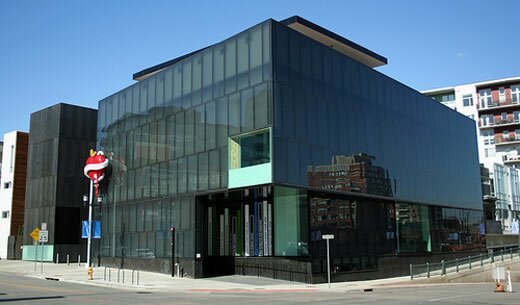
A few days ago Dan Goddard posted some interesting details on the museum that will house the contemporary art collection of Linda Pace:
By this fall, the foundation expects to select a site in San Antonio for the construction of a permanent home for Pace’s contemporary art collection, including works by Willem de Kooning, Olafur Eliasson, Isaac Julien, Richard Tuttle and Rachel Whiteread. British architect David Adjaye, who designed the Museum of Contemporary Art in Denver, is working on the project.
Some are anticipating that the museum, when completed, will be as important as the Menil in Houston (we’ll see…). Adjaye has already created a model for the museum which was sort of viewable through the glass of a locked office door in the Linda Pace Foundation offices during an event last night. I just caught a quick glimpse, but the model seemed less boxy than some of Adjaye’s more well-known projects, such as the Museum of Contemporary Art in Denver (above).
An exhibit of Adjaye’s work will be traveling to the Hudson (Show)Room at Artpace in September. The show, organized by London’s Whitechapel Art Gallery, is called “Making Public Buildings” (a catalog is ). As usual with Hudson shows, Adjaye will be giving a walk-through at the opening on September 11. In addition to high-end London homes and public buildings such as museums and libraries, Adjaye has collaborated with artists Olafur Eliasson (see here) and Chris Ofili (see here) on projects that blur the line between visual art and architecture. Adjaye’s buildings are noted for their experiential sensitivity and their ability to respond to the surrounding environment.
We’ll give you more details as we get them…
Posted by justin on 26 May 2008 | Tagged as: acquisitions, adventure day, art paparazzi, arts organizations, celebrity sightings, possibilities, sneak peeks
Invites have been circulating recently for a reception to mark the opening of the new Linda Pace Foundation offices (adjacent to Pace’s Camp Street residence) that have been quietly renovated over the last year or so. I noticed on my bike ride to the gallery last week that the big blank wall facing S. Flores had been installed with a new text piece. After some research, I’m concluding it is one of the new pieces of the Pace collection, mentioned in the reception invite as a Daniel Joseph Martinez. The invite mentions two new acquisitions for the Foundation, no info as to the other has yet surfaced.
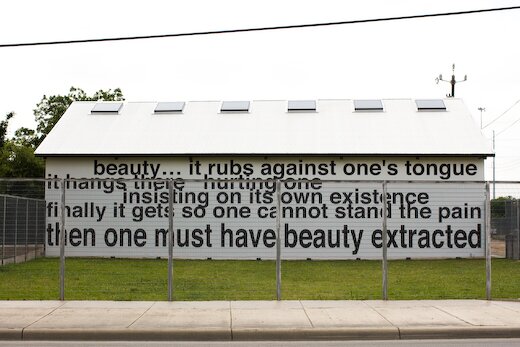
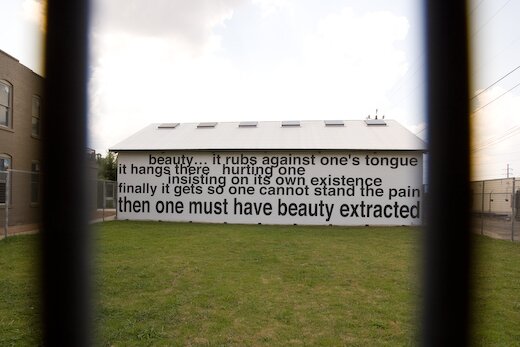
Posted by ben on 06 May 2008 | Tagged as: acquisitions, arts organizations
Kriston Capps details a major gift to the Blanton from collectors Dorothy and Herbert Vogel in the Dallas Morning News. The gift will include work by 26 artists, including Elizabeth Murray, Richard Prince Pettibone, Lawrence Weiner, and Richard Tuttle.
Posted by ben on 15 Apr 2008 | Tagged as: arts organizations, politics
When various folks in the art world became concerned recently that Smithson’s Spiral Jetty was going to be threatened by new oil exploration, I wondered what the big deal was. As I understand it, when Smithson created the piece, the site was very close to an industrial jetty actively used for oil exploration. In a new piece for The American Prospect, Kriston Capps addresses this point and much more. What’s most interesting about this situation, though, is that there appear to be genuine ecological concerns with oil exploration in the lake — and yet it is the Spiral Jetty that has rallied people from around the world to object to the drilling. According to Capps:
Though some of the complaints were more generic in nature — oil wells are never welcomed with open arms, even in remote areas like Rozel Point — Jemming characterized the overwhelming majority of correspondence his office received as primarily “comments related to the Spiral Jetty from the arts community.”
Give the piece a read for an interesting look at the intersection of art, ecology, and politics. TAP also has a Q&A with Nancy Holt, Smithson’s widow, and Lynn de Freitas, director of Friends of Great Salt Lake.
Posted by ben on 14 Apr 2008 | Tagged as: arts organizations, borders, politics, responses/reviews
There have been a few little dust-ups in the art world lately regarding conflicts of interest among art critics. Edward Winkleman has the skinny on a feud between art critics Tyler Green (of Modern Art Notes) and Christian Viveros-Fauné (formerly of the Village Voice). Green likes to split his blogging time between criticism and more journalistic pursuits, such as scooping the big papers on the departures of major museum directors. He also likes to call out arts writers for lacking journalistic integrity. After Green pointed out that Viveros-Fauné is a director of the Volta art fair, and an organizer of Chicago’s Next art fair, Viveros-Fauné was canned from his Village Voice position over what was seen as a conflict of interest. Of course, Viveros-Fauné then accused Green of being a self-promotional wanker (spelling Green’s name with an extra ‘e’, presumably to thank him for leaving the accent off Viveros-Fauné in an interview published on Modern Art Notes).
Now this battle has broadened a bit (the comments on Winkleman’s post give a good idea of the range of opinions), and people seem to be dividing into two camps: art critics should follow journalistic standards; or art critics should do whatever the hell they want, they will be judged according to the quality of their writing, period.
When it gets down to it, the art community is entering a phase of commercialization that makes this a very difficult issue to address. As more money flows into the contemporary art world, and as people start to see art as more of a financial investment, the problems that Tyler Green addresses become much more important. Investors want transparency and high ethical standards. However, this commercialization has met with resistance in some quarters, among people who feel that art should be free of the taint of commerce as well as the kind of compartmentalization that these ethical standards often bring.
Artists want to be free to write about art, open their own art spaces, curate shows with artists they respect (often their friends) and ultimately participate in the art community on multiple levels. Everyone who writes for this blog, for instance, also produces art, and two of us have directed gallery spaces while writing about art. The idea of keeping these functions totally separate is, for many of us, antithetical to the freedom and openness that art allows.
So where do I stand on this? Well I’ll just say that I think it’s a good debate to be having. But before addressing the ethical issue per se, we need to clarify our positions on the relationship between art and money. To the extent that art is a commercial endeavor, Tyler Green is right: we need clearly defined roles that prevent conflicts of interest. To the extent that art is about investigating new ways of seeing the world, these roles have the potential to trap us in an overly calcified artistic space.
Update: Tyler Green comments to clarify that he does not see this as a feud between himself and Mr. Viveros-Fauné.
Posted by ben on 16 Mar 2008 | Tagged as: arts organizations, possibilities, responses/reviews
I’m still collecting thoughts and reactions from Luminaria, but here’s my initial post-event take on how it all turned out. While a lot of my pre-Luminaria criticisms still stand, I think these problems need to be put into perspective. First of all, I think for most people who made it downtown (and there were a lot of folks out there), the organizational problems were not really apparent. The events flowed well, there was a lot of good energy and big crowds, but it was never difficult to get to where you wanted to be, and there seemed to be plenty of strategically located food and drink stands, port-o-potties, etc. The event planners and promoters did their job, and everyone I talked to seemed to really enjoy the night.
As expected, there was a pretty big range in both the style and the quality of art presented. As I pointed out earlier, I think Luminaria could benefit from more competitive funding opportunities. I’d like to see a process in place that would allow museum-quality artists to create new work specifically for Luminaria — site-specific installations, sculptures, projections, etc. There’s no way this will happen unless a bigger chunk of money is available to participating artists. But I also think Luminaria needs to keep the inclusive feel that was achieved last night. Things felt very open, with the symphony playing across the street from fire dancers and around the corner from an open-mic poetry reading, work by Chuck Ramirez and Katie Pell across the street from student art.
One criticism I made earlier was that the city didn’t try to build on existing, grassroots art events like First Friday or Contemporary Art Month. Last night I realized why this would have been a bad idea. Luminaria is really a different beast from these events, which mostly rely on independent venues to do their own thing, and have very little central organization. But at the same time, these existing art events have a lot of interested parties who would probably feel that the city was hijacking their event. Luminaria needed to start fresh, and put something together that isn’t identified with a singular community, but represents the diverse artistic talents that exist throughout San Antonio. And they also needed to be able to have a strong, central organizational structure that these other events, for the most part, lack.
Overall, I think Luminaria was clearly a successful event, with plenty of room for improvement. Many of San Antonio’s best artists were not represented, but I think people got a good sense of the diversity and energy that exists in San Antonio’s artistic communities. And the city spared no expense on capping it off with a great fireworks display off the roof of the Emily Morgan.
We’ll be posting some photos later this afternoon. Stay tuned…
Posted by ben on 14 Mar 2008 | Tagged as: arts organizations, politics, possibilities, rumors, upcoming events
San Antonio’s Luminaria arts night kicks off tomorrow, and the general sense of discontent in the contemporary arts community seems to be growing. I have talked to several artists who were promised funding, and then told at the last minute that their projects will not be funded, forcing them to drastically scale back their projects and/or scramble for private backing. Then there’s the little problem of scheduling the event during Austin’s SXSW, which tends to soak up a lot of attention. This has led San Antonio’s own newspapers to give Luminaria short shrift in favor of covering the star-studded music festival up I-35.
But the biggest problem is the perceived disconnect between the event planners and the actual artists who could make this festival meaningful. Rather than trying to build on existing, grassroots art events like First Friday, Contemporary Art Month, Art in the Hood, or SMART Fair, the city chose to reinvent the wheel. What’s worse, they don’t seem to be listening to the people who are deeply involved in the day-to-day work that has given San Antonio such a rich variety of artist-run spaces and events.
Naturally, part of the problem is money. Some (including myself) feel that at an event receiving a large chunk of city funding, as well as support from Bank of America, AT&T, Ford, and Valero, the artists themselves could hope for more than a $200 honorarium. If even $10,000 or $20,000 (a small fraction of the budget) was made available on a competitive basis, a number of successful local artists might have thrown their hat into the ring rather than sitting this one out. The talking points coming from City Hall point out that artists will be “paid in exposure” — but then, of course, all the established and semi-established artists who already show their work at good galleries in New York and other art centers have no incentive to participate. And so Luminaria has been engineered to showcase artists desperate for exposure, rather than those who have hit their stride and earned some level of national recognition. This approach sells everyone short, and implicitly sends the signal that Luminaria is not a venue for recognized artists. It also ignores the reality that a lot of art takes money to produce — artists have to invest more than just time and energy to realize an ambitious project.
However, despite all this, a number of talented artists are participating in Luminaria, and if the city can provide basic organizational support, the arts night could turn out to be a valuable venue. While some artists are distancing themselves from what seems more and more like a potential train wreck (from the artist’s perspective), others are throwing their talents into the mix to see what happens. And despite what I’m sure sounds like a pretty negative pre-judgment of Luminaria, I’m really interested to see what happens. I’m sure there will be some successful projects out there tomorrow, and I’m sure the city will provide the basic infrastructure necessary for this kind of event. I’m just worried that it will fall short of the potential, and that many artists will be alienated by the lack of respect for their achievements and the realities of their profession. Check back soon for post-Luminaria reactions.
Posted by ben on 04 Mar 2008 | Tagged as: arts organizations, politics
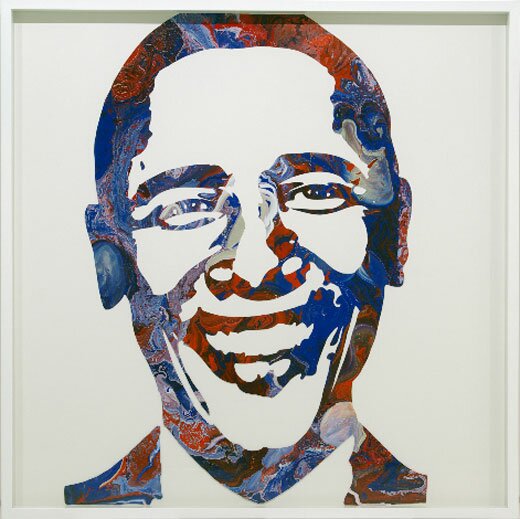
Obama by Zane Lewis
Coincidentally (as far as I can tell), Kriston Capps and Edward Winkleman both posted on Barack Obama’s arts policies today. (I’m guessing they’re focusing on Obama because he’s the only major candidate to put out much of a policy statement on the arts.) Capps lays out Obama’s modest but well-intentioned white paper on the arts, and then suggests a couple of policies of his own. First he suggests amending the tax code as it relates to fractional gifting of artworks to museums. Second, he advocates for the creation of a Department of Culture:
Nothing would do more to promote cultural diplomacy and attract foreign talent than to join the world by creating a proper ministry of culture. And in fact, recent experience has proved that the United States cannot afford to act without one. The disastrous looting of historical artifacts from Iraqi museums and sites might have been avoided if there were an official organ advising the President on the cultural situation of nations and regions that also represent strategic U.S. interests. To the extent it behooves relations for the New York Philharmonic Orchestra to play Pyongyang, it behooves the nation to seek out and sanction similar opportunities. And by all means, a Department of Culture could guide policy.
The upshot of Winkleman’s post is that although arts education should be funded,
I don’t think art’s potential as a social force in its own right is affected by how much the government supports it financially as much as personally, actually. I think a President should demonstrate this potential by inviting artists to the White House and being seen taking in exhibitions at museums and such, sending the message that art appreciation is a personal experience. Trying to suggest it benefits our national soul will enrage a good portion of the population. You can’t make that horse drink.
Posted by ben on 06 Feb 2008 | Tagged as: announcements, arts organizations, politics

The Spiral Jetty oil drilling story (broken by MAN) is picking up steam, with a little mention in the NYT, and a couple of hot-out-of-the-oven press releases. The Dia Foundation “adamantly opposes” the drilling, which it says would take place within 5 miles of Smithson’s iconic land art masterpiece. The National Trust for Historic preservation has also entered the fray. I can’t find a link to a press release from them, but the Trust’s president Richard Moe is quoted as saying “The National Trust for Historic Preservation believes that Robert Smithson’s Spiral Jetty on the Great Salt Lake is a significant cultural site from the recent past, merging art, the environment, and the landscape. We are deeply concerned about the potential harm that energy development could bring to the Spiral Jetty.”
Interestingly, the Spiral Jetty was originally situated “a few hundred yards” from another industrial jetty, which was used for oil exploration for 60 years, and was actively being used for at least 10 years after Smithson built the piece. As Tyler Green noted in a piece on the Jetty from 2005:
A few hundred yards east of Smithson’s spiral is an old industrial jetty, used for oil exploration from the 1920’s to the 1980’s. It is rotting toward dissolution. While he didn’t write about it, Smithson saw it when he was building Spiral Jetty. He must have known that the oil jetty would eventually decay and disappear, while his artwork would survive, forming a partnership with nature. It will last.
So I have to wonder how detrimental this drilling really is to the Spiral Jetty Experience, considering oil exploration was happening within a few hundred yards of the piece for 10 years or more after its creation (Smithson completed the Spiral Jetty in 1970). Maybe this new drilling operation would be more invasive somehow, or maybe I’m misunderstanding the role of the older jetty. But if Smithson picked a location where he knew oil exploration was ongoing, maybe it doesn’t really impact the work in a negative way. Did any of our readers visit the Spiral Jetty in the ’70s or ’80s while this oil exploration was active?
On the other hand, I’m inclined to trust the Dia Foundation to understand the intended presentation of the Spiral Jetty about as well as anyone. And the fact that they only put out their press release today suggests that they spent some time considering the issues before reacting. Anyway, if you want to weight in officially, Dia has put together a form letter to express opposition to the project, along with relevant contact info.
There’s more: I just caught wind of this article in the Salt Lake Tribune, which fleshes out some of the legal and ecological issues surrounding the proposed drilling. Near the end, the author of the piece states that “the state must honor mineral rights.” It sounds like the company already has a lease on the land, which was exempted from a conservation agreement between the state of Utah and several conservation groups.
Posted by ben on 31 Jan 2008 | Tagged as: adventure day, art paparazzi, arts organizations, celebrity sightings, interviews, outsider
A little while back we did a series of posts on publicly accessible outsider artwork in San Antonio. One of the artists we covered was the Rev. Seymour Perkins, a controversial figure who lives on the east side of town. While others argue over whether he harbors drugs and prostitutes, and his lawyer battles with the city over the fate of his home, we here at Emvergeoning decided to take another peak at the work that isn’t so publicly accessible — the work inside his home. As Rev. Perkins gave us the tour I tried to absorb all the details, while Justin Parr snapped shot after shot of the inner sanctuary. From what I was able to gather, Seymour Perkins’ daughter, Debbie Jo Christi, was killed in a drug-related conflict on February 22, 1994. Here is a drawing on one of the walls that depicts her murder:
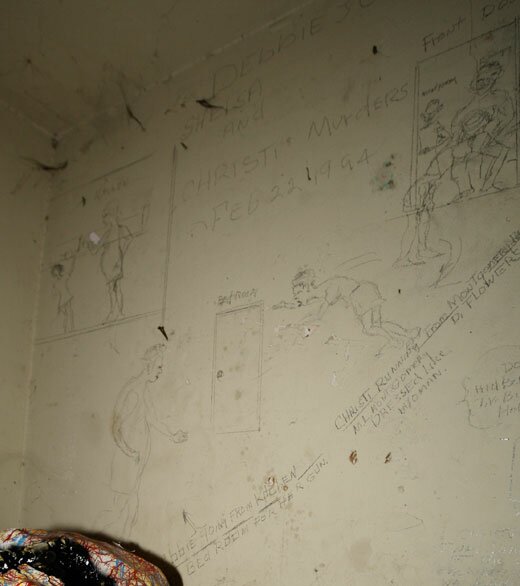
On the same day, the tallest angel in Heaven appeared to Seymour Perkins, revealing to him a tunnel that runs under his home, which is in fact the famous Underground Railroad. This tunnel connects his home to the Alamo and the Menger Hotel, and runs on down into Mexico. After receiving this prophecy (which I am recounting in only a very fragmentary and woefully incomplete way), Perkins founded the Debbie Jo Christi Museum, and Hanging Tough Ministries. Here is a painting of the tunnel running under the Perkins estate:
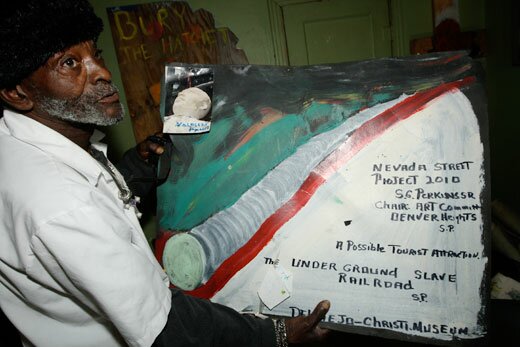
Here are a few shots inside the Debbie Jo Christi Museum:
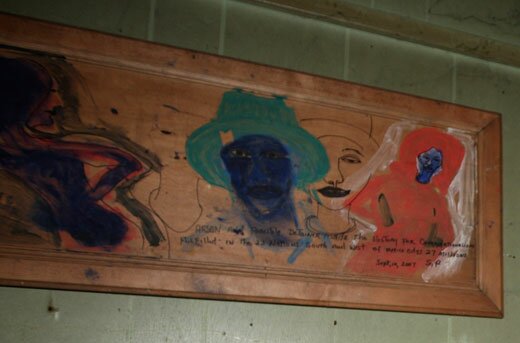


The Museum is located in a small building in the back of the house. But within the actual house, where Rev. Perkins delivers most of his sermons, there are a number of fascinating works. In his bedroom, the pieces below are painted on the wall. The first is a self-portrait of Rev. Perkins with his son:
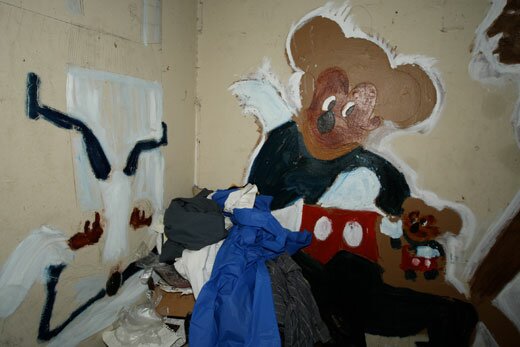
Next to this painting, is a larger work depicting one of his assistants, whose ass is stuck to his ass (i.e. he doesn’t know if he’s coming or going):
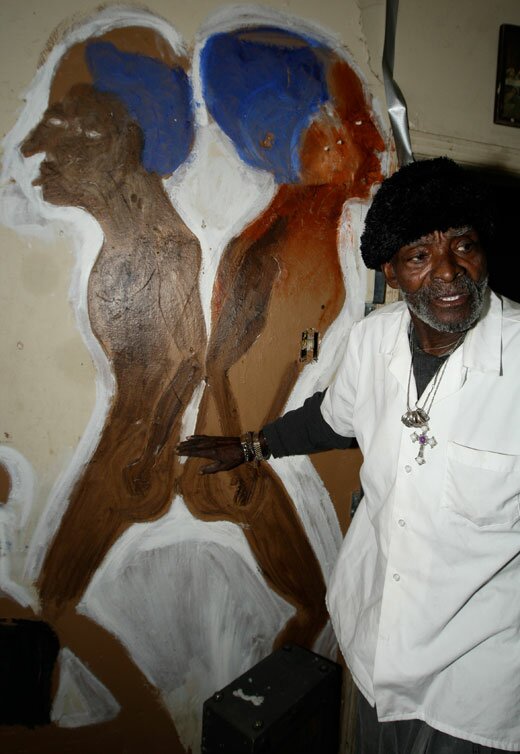
Below are a few details of one work painted on a window shade, depicting a man named Timothy Ringer, “the funkiest man in San Antonio”:
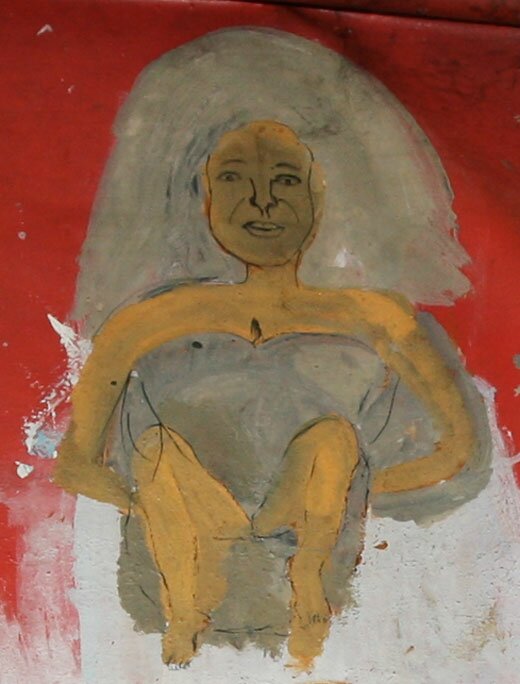

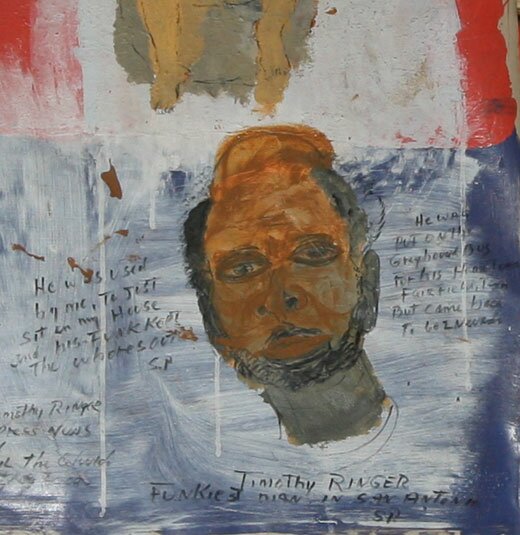
In addition to these works, dealing with himself, his family, and other meaningful people in his life, Perkins showed us a few pieces dealing with his relationship with God and History:
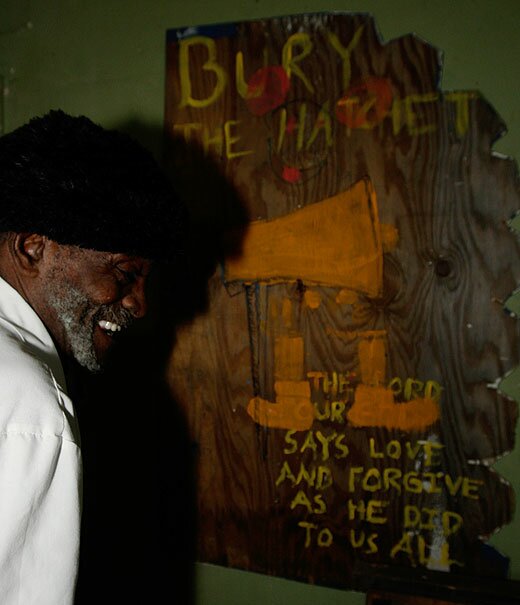
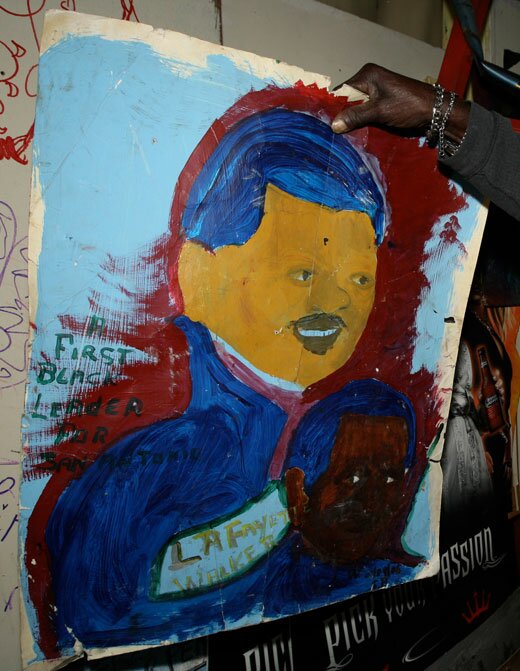

Now, this post isn’t intended to rally support around Rev. Seymour Perkins, or to say anything about his proper place in our community. I’ll leave that to his neighbors, his lawyers, and the city’s elected officials. But I did think it would be good for people to see what is inside his home — if it is destroyed in the coming months, this may sadly be one of the most complete documents of what it contained. To see more of his work, please visit the San Angel Folk Art gallery in the Blue Star arts complex.
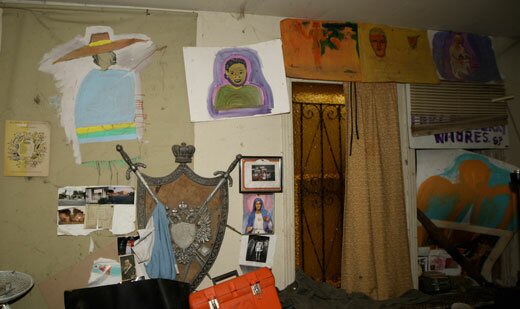
Posted by ben on 20 Dec 2007 | Tagged as: arts organizations, comics, graffiti, responses/reviews
I feel bad for Alex Rubio. A month after his residency at Artpace ended, he had to put together a whole new exhibition of work for Museo Alameda. And although he pulled it off, the differences between the shows are revealing. Both exhibits are based around the idea of community; at Artpace, Rubio orchestrated an installation that combined the talents of local artists ranging from graffiti artist Shek to metal sculptor Luis Guerrero to neon and glass artist Cathy Cunningham; the Alameda mounted a two-person show by Rubio and his former student Vincent Valdez, which emphasized their shared history in San Anto (Rubio on the west side, Valdez on the south side). The Alameda show also brought in some community artists to accentuate the work with neon and sculpture, but remained primarily a showcase of the two artists’ paintings.
Let me start off by saying that both shows were successful, and anyone who hasn’t seen them yet should make the effort to drop by Artpace and the Alameda before they go down (the Artpace show runs through January 6, while the Alameda show closes March 23). At Artpace, Rubio orchestrated an installation that seamlessly blends the talents of a wide range of artists into a work that fits right into Rubio’s oeuvre. Organizing a community of artists around a singular vision is no easy task, and Alex Rubio pulled it off.
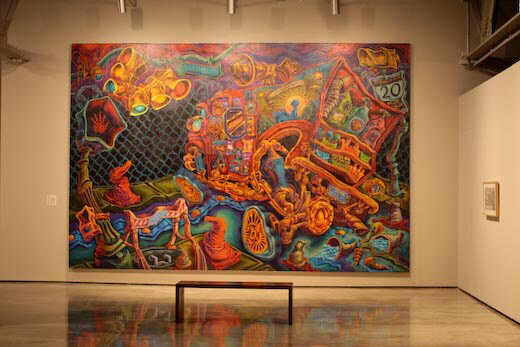
The Museo Alameda’s exhibit, curated by Benito Huerta, has a different goal: to juxtapose the work of two San Antonio artists with common yet divergent paths. The reason this show works is that the cinematic drama of Vincent Valdez’s work provides an effective counterpoint to the twisted, psychedelic visions of Alex Rubio. Both artists embrace the gritty reality of the streets in their native barrios, and bring into full view both the pride and the laments of their cultural heritage. Yet the divergent means through which they approach these realities tinges the community they depict with two distinct flavors. Valdez’s aesthetic could be drawn from the films of Scorsese, with their visceral impact and complex, yet direct, realism. At the same time, Valdez weaves a contemporary symbolism into his work, imbuing it with a sense of cultural depth. Rubio, on the other hand, seems to owe more to the psychedelic exploration of underground comics or even rock concert posters, while bringing this stylistic vocabulary to a new level of complexity and vibrant energy.


But when your eye drifts from the paintings, the rough edges start to become apparent. A huge map of San Antonio reminiscent of a pirate treasure map is prominently installed in the exhibit, highlighting the artists’ neighborhoods and showing the locations of significant events in their lives. Besides being difficult to read, this map, when at long last it is deciphered, brings very little to the paintings, which clearly convey a coherent experience of the world. Neon hands designed by Valdez forming the “signs” for the North, South, East and West sides feel tacked on; and a sculpture of the boxer in Valdez’s paintings lacks the emotional depth and formal strength of the original.
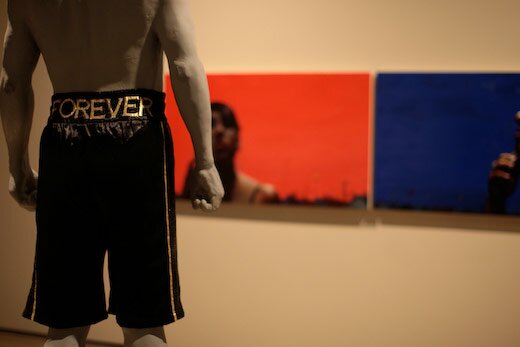
Still, this show is about the paintings, and the paintings succeed.
Posted by ben on 06 Dec 2007 | Tagged as: arts organizations, responses/reviews
Joe Solis’ recent article in the Current critiquing the Museo Alameda has a number of problems, although I agree with the general sentiment that the Museo needs to improve its curatorial work and engage with a broader spectrum of San Antonio’s Latino (and non-Latino) community. Two recent developments give me hope that the Museo leadership is starting to realize the importance of these goals.
First, the initiation of a “free day” (with outside funding) will encourage the lower-income segments of the community to explore what the Museo has to offer. Oddly, Solis takes umbrage at this free admission day, calling it a “bribe”. He cites the popularity of other local museums to show that the Alameda doesn’t need to allow free admission — but he completely ignores the fact that two of the three museums he cites also have “free days”, and that it is a standard practice in the museum industry. He’s right that this isn’t going to solve all the museums outreach problems, but it is certainly a step in the right direction.
On the curatorial end of things, the Museo has finally put together a show I’m genuinely interested in seeing. Alex Rubio and Vincent Valdez, two well-respected local artists, will be sharing the museum for an exhibition called “Pride of the Southside: En el Mero Hueso”. This show should certainly bring out the art community in droves (Rubio’s recent show at Artpace was packed), and should also be the kind of work that a broader audience can connect with. It should even entice those people alienated by recent Alameda shows that politicized Day of the Dead and anglicized the huipil. Solis doesn’t even mention this exhibit, which opens next week, in his article.
Again, any real solution to the lack of outreach and weak programming will have to involve deeper changes in the Museo, but I’m seeing some encouraging developments at “the pink lady on Commerce” (as Solis calls it), which I hope are indicative of a more meaningful long-term strategy and a shift in the administrative culture (this will be the key).
P.S. Note to Joe Solis — the Museo Alameda is not a “division of the Smithsonian Museum”, not by a long shot. The Museo Alameda is a Smithsonian Affiliate, along with many other museums around the country. The Current should run a correction.
UPDATE: I just learned that the Museo Alameda pulled an ad from the Current due to Solis’ article. The ad was for the upcoming Alex Rubio / Vincent Valdez exhibit. If the leadership at the Museo thinks this is the best way to address criticism from the media, then it is clearly working against the organization’s own stated mission. The Museo was apparently built to encourage dialogue between cultures, but as soon as a discussion about the efficacy of the organization begins, the folks at the Alameda try to shut it down. Solis rightly identified a deficit in the Museo’s outreach efforts; in response they damage that very outreach effort in an act of petty retaliation. This mindset, if it continues, is going to doom the museum and ultimately damage the community it is apparently trying to enrich. This isn’t about whose “team” we’re on; it’s about working together as a community towards mutual understanding and respect. If the Alameda wants to shut down dialogue, then they do so at their own risk. Currently the conventional wisdom in the arts community is decidedly critical of the museum; even if the Museo is able to blackmail every media source into silence, that won’t change a thing.
UPDATE 2: The Current has also covered the Alameda in the context of their city funding, and Chairman Henry Muñoz’s involvement with the city-funded Luminaria arts night. This is, I think, a more sensible and well-researched piece. It also has a fabulous photo of Muñoz.
Posted by ben on 25 Nov 2007 | Tagged as: arts organizations, opportunities, upcoming events
San Antonio mayor Phil Hardberger has thrown his weight behind a downtown “arts night” called Luminaria to take place on March 15, 2008. A few people in San Antonio’s grassroots contemporary art scene are trying to make sure that this community is involved. Jason Stevens (of Potter-Belmar Labs) has started a Luminaria blog to give some information on the event until the official site is up. Jason has posted a map showing where the event will take place on Houston Street, an artist proposal form, and more details about the event and how it is being organized.
There have been rumors that out of a $200,000 budget, no money for this event was set aside for artists. These rumors appear to be false, and money will be available for artists to cover expenses, although not for honorariums. We’ll try to keep you posted on future developments.
UPDATE: As noted in comments, the official Lumaria web site is now up and running.
Posted by ben on 28 Oct 2007 | Tagged as: arts organizations
I just received news that Garth Clark Gallery in New York, one of the best contemporary ceramics galleries anywhere, is closing. According to the co-owner of the gallery, Mark Del Vecchio:
After 27 years and over 600 exhibitions we have decided to go “private” and “by appointment only”. We no longer represent artists and no longer present exhibitions. This has been a difficult decision to make but we are somewhat burned out after all our years of rotating exhibitions and while we remain in business in the same locations with the same phone numbers, this limited time frame will allow us to grow in new directions. We will do “salons” from time to time in which the gallery will be open for an evening but otherwise we have our door closed on 57th street and are working privately with collectors and museums selling resale works from the latter part of the 20th century.
As we noted back in June, the Museum of Fine Arts, Houston is acquiring 375 pieces from the Garth Clark Mark Del Vecchio collection, which will be unveiled in May, 2008.
Posted by justin on 15 Oct 2007 | Tagged as: adventure day, art paparazzi, arts organizations, in yo face, party photos, performance art
Posted by ben on 27 Sep 2007 | Tagged as: arts organizations, renegade performances
A lot has been written about the dispute between Christoph Büchel and MASS MoCA, so I won’t bother to summarize here (check out this post at a Walker Art Center blog for background). The ultimate resolution will have important implications for artists and museums, so it’s worth keeping an eye on. Tyler blames both the artist and the museum for the dust-up; the artist for being a jerk and the museum for not realizing this project would be a fiasco from the beginning (especially considering what a jerk Büchel is).
I wanted to note a couple of interesting tidbits about the case. First, the “final straw,” when the museum decided to break up with Büchel, was an item he requested that the museum procure: “the fuselage from a large jetliner, like a 767, that Mr. Büchel wanted to be burned and bomb-damaged and then hung from the ceiling.” Second, the fact that the judge in the case has deemed that the museum is a collaborative partner with Büchel, giving them at least some claim to the copyrights to the work (is this a first?). I don’t think MASS MoCA will actually try to claim any ownership of the work, but the precedent could prove consequential.